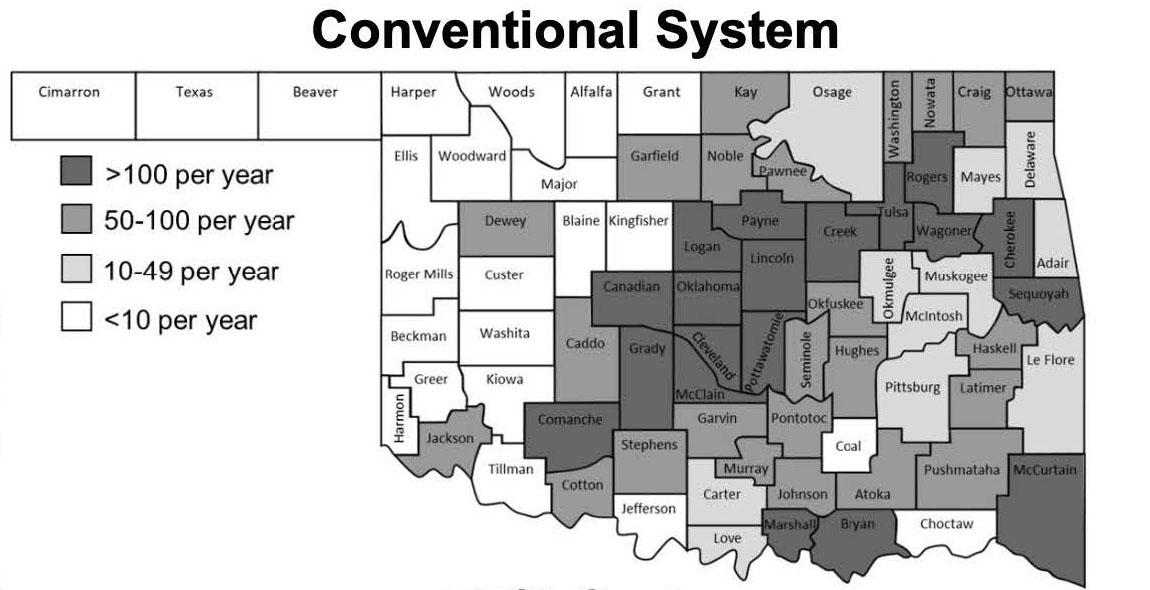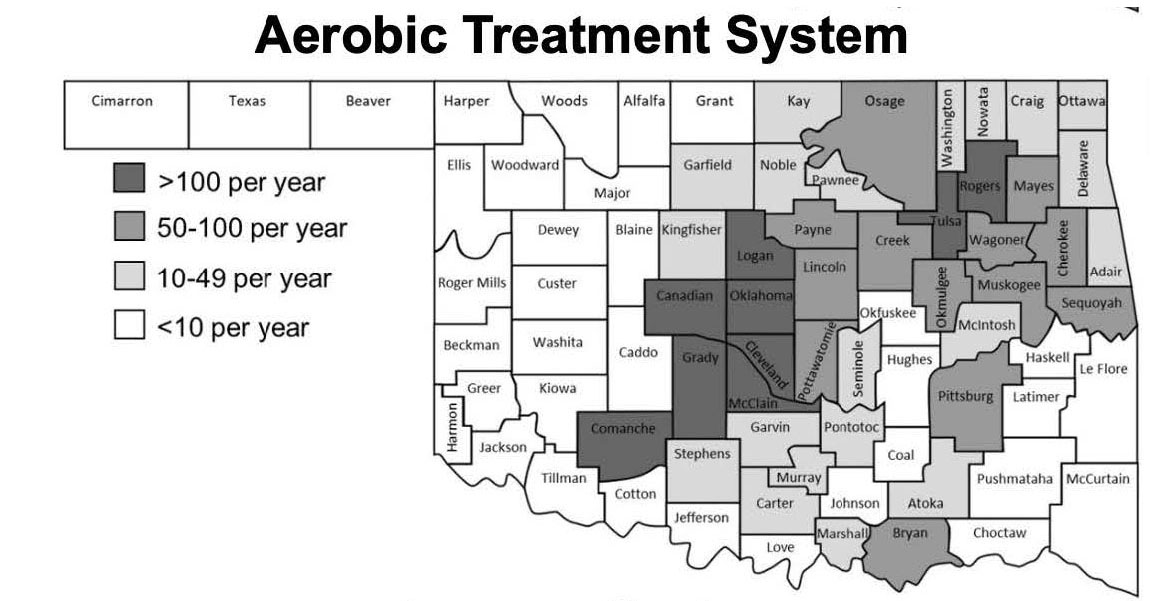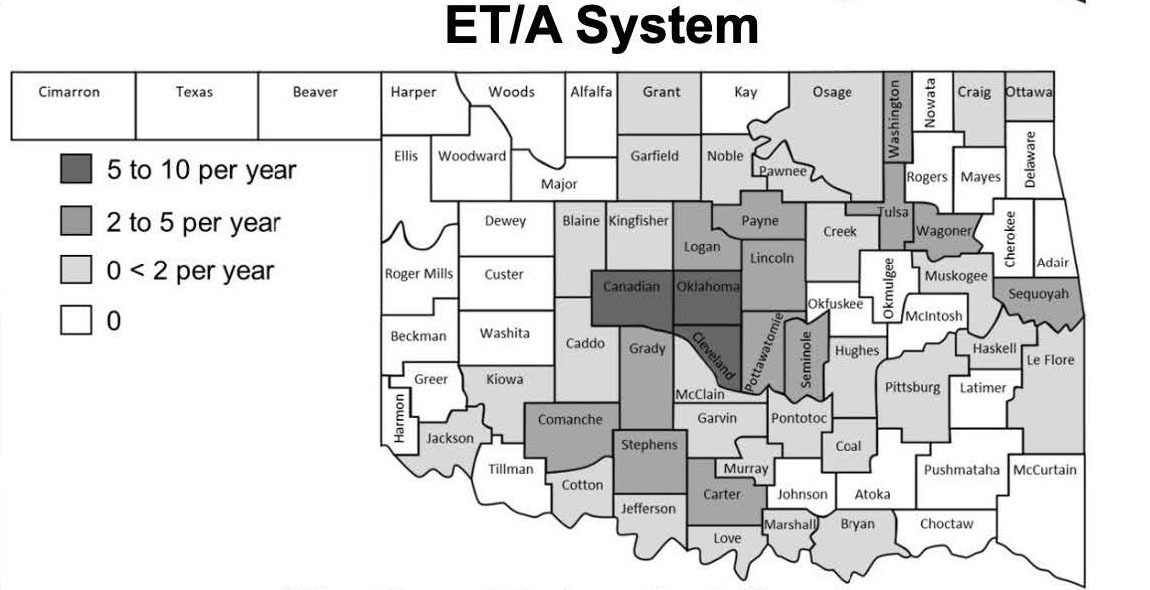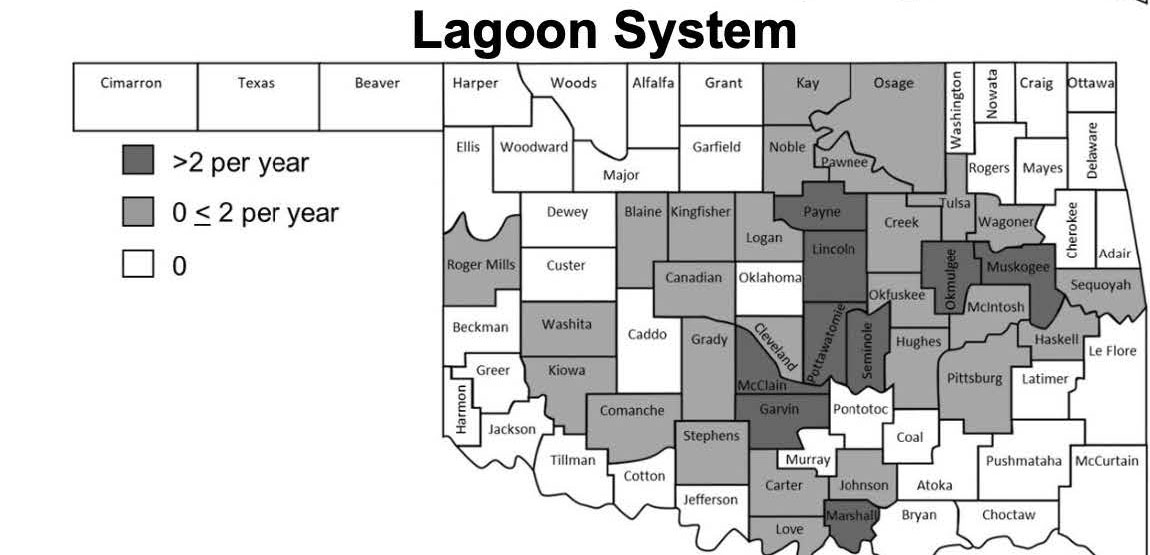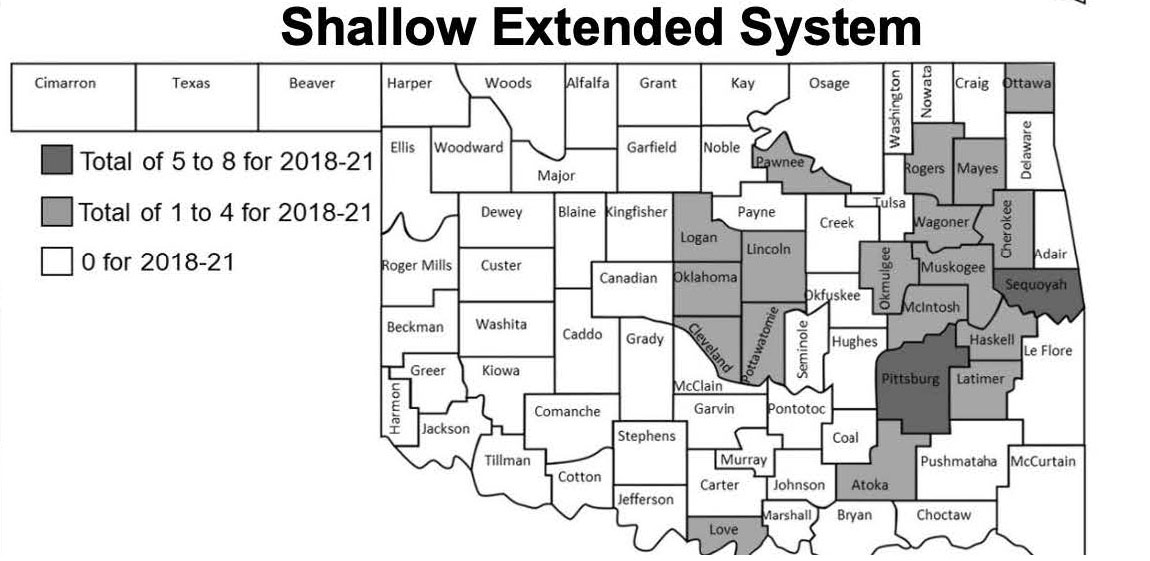Septic System Trends in Oklahoma
Houses outside the service area of municipal or city sewer systems need onsite wastewater treatment systems (or septic systems) to treat household wastewater. From 2002 to 2021, 49% of all new houses built in the state have septic systems. Moreover, 59% of single detached houses built in Oklahoma since 2002 have septic systems. Clearly, the use of septic systems in the state is very common particularly when compared with the nationwide estimate of only 20% (Fig. 1).
This fact sheet is focused on the types, number and geographical distribution of septic systems installed in the state from 2002 to 2021. Aside from being a source of information about recent septic system trends in Oklahoma, this bulletin may also be used as a reference to formulate business decisions by stakeholders in the septic systems industry (e.g., installers, haulers and pumpers, suppliers and manufacturers). Policy makers may also use this information when considering adjustments in septic systems-related regulations and training programs.
Figure 1. Percentage of houses with septic systems nationwide and in Oklahoma. (Source: USEPA). (Data sources: US Census Bureau and Oklahoma DEQ).
Types of Septic System
There are six types of septic systems ordinarily permitted in Oklahoma. They are as follows: conventional system, shallow-extended subsurface system, low pressure dosing system, evapotranspiration/absorption (ET/A) system, lagoon system and the aerobic treatment system. For details about each of these systems, refer to Extension Bulletin PSS-2913: Onsite Wastewater Treatment Systems Permitted in Oklahoma. Lowpressure dosing systems are hardly ever installed in the state and hence, is not covered in this fact sheet.
The Septic System Industry and the House-building Industry
The septic systems industry is closely tied to the house-building industry. As many as 9,200 systems were installed in Oklahoma during the height of the housing market in 2005, but decreased to only 4,700 units when the market was down in 2012 (Fig. 2). Recently, the number of new houses built increased from 10,502 in 2018 to 14,733 in 2021. Over the same period, the annual total of septic systems installed in the state has increased from 4,888 to 6,536. Factors that impact the house-building industry such as mortgage interest rates, cost of building materials and the demand for newly-built houses are expected to have a continued effect on the septic systems industry.
Figure 2. Trends in new total houses and single housing units built in Oklahoma along with the number of septic systems installed annually from 2002 to 2021. (Data sources: US Census Bureau and Oklahoma DEQ).
Trends in Septic System Installations in Oklahoma
Until 2012, the conventional system (also known as pipe-and-gravel system) was the most common septic system in Oklahoma (Fig. 3). Conventional systems do not require electricity to function because flow of the wastewater through various components is driven by gravity. This system requires the least maintenance, but needs good soil and a relatively large land area for installation.
Figure 3. Trends in relative percentage of various types of septic systems installed in Oklahoma from 2002 to 2021. (Source: Oklahoma DEQ).
The aerobic treatment system/unit (ATU) has become the most popular system in the state since 2013 and the gap between ATU and the second most popular system (conventional system) has continued to widen since 2014 (see Fig. 3). ATUs may be installed in less-than-ideal soils (shallow-to-rock, very fine or very coarse soils) and require a relatively smaller land area. However, ATUs use electricity and have the most intensive maintenance requirements among the systems installed in Oklahoma. In addition, ATU is now the dominant type of septic system in 47 out of the 77 counties in the state (based on data from 2018 to 2021; see Fig. 4). In contrast, conventional system was the dominant system in 40 out of 77 counties in 2017. Current trends, therefore, show that use of a septic system that requires electricity and frequent maintenance is increasing and is expected to become even more common in the foreseeable future.
Figure 4. Dominant type of septic system in each county in Oklahoma from 2018 to 2021.
Distribution of Septic Systems Across Oklahoma
The need for new houses influences the distribution of new septic system installations. The greater metropolitan areas of the cities of Tulsa and Oklahoma City have eight of the top 10 counties in terms of population growth in the state (Census Bureau, 2021a). With an increase in population comes a greater need for new houses and as expected, these areas also have the highest number of new septic system installations (Fig. 5). This is particularly true for ATUs and conventional systems – the two most common systems in Oklahoma.
Figure 5a. Total of All System – County averages of the number of various types of septic systems installed in Oklahoma from 2018 to 2021. (Data source: Oklahoma DEQ).
Figure 5b. Conventional System – County averages of the number of various types of septic systems installed in Oklahoma from 2018 to 2021. (Data source: Oklahoma DEQ).
Figure 5c. Aerobic Treatment System – County averages of the number of various types of septic systems installed in Oklahoma from 2018 to 2021. (Data source: Oklahoma DEQ).
Figure 5d. ET/A System – County averages of the number of various types of septic systems installed in Oklahoma from 2018 to 2021. (Data source: Oklahoma DEQ).
Figure 5e. Lagoon System – County averages of the number of various types of septic systems installed in Oklahoma from 2018 to 2021. (Data source: Oklahoma DEQ).
Figure 5f. Shallow Extended System – County averages of the number of various types of septic systems installed in Oklahoma from 2018 to 2021. (Data source: Oklahoma DEQ).
Soil properties such as texture (coarseness or fineness of soil) and the depth to a flow-restricting layer largely determine whether a certain type of septic system will be permitted for installation at a site. Because soil texture and the thickness of the soil varies across the state, we expect the types of required septic systems to also vary. In Payne County for example, areas in Perkins with medium-textured soils are generally permitted for conventional system installation, but just a few miles northwest in Stillwater, ATUs are widely required due to the predominance of finer-textured soils. For more details about the influence of soil properties on septic system decisions, refer to Extension fact sheet PSS-2271: Soil-based Septic System Decisions in Oklahoma.
Rainfall rate and frequency and evapotranspiration (ET) rates also drastically vary across the state, and they affect the distribution of septic systems. For example, there are very few evapotranspiration/absorption system and lagoon systems at the southeastern region of the state (see Fig. 5). This is because low potential ET and high rainfall rates in these areas do not favor the optimum functioning of these two systems.
Being in an Oklahoma DEQ-designated Water Body Protection Areas (WBPA) also affects the type of system that is permitted for installation. Regardless of soil properties and climate conditions, areas in the WBPA, specifically those within 300 feet from a listed water body or a stream bed, require ATUs with a nitrogen-reduction component.
Key Points and Implications
Around 50% of houses built in Oklahoma since 2002 have septic systems. An average of 5,420 new systems were installed in the state in each of the last four years. In 2021 alone, 6,536 new septic systems were installed which could collectively treat around 573 million gallons of domestic wastewater annually (assuming that each new house uses 240 gallons of water per day). This implies that the septic systems industry plays a significant role in protecting Oklahomans and their environment from possible ill-effects of improperly treated domestic wastewater. Since 2018 there has been an increasing trend in septic system installations in Oklahoma indicating a positive short-term outlook for the septic systems industry.
The shift from conventional systems to ATU as the most widely used septic system in the state means that Oklahoma now mainly uses a high-maintenance system with the most components that could possibly malfunction. Considering this drastic change, it is prudent to revisit regulations that govern the maintenance requirements for ATUs, and for septic systems in general.
Data Sources/Sources of Information:
Oklahoma Department of Environmental Quality. 707 N Robinson Oklahoma City, OK 73102. Information about septic systems received in April 2022.
References
United States Census Bureau. 2021a. Annual Estimates of the Resident Population for
Counties: April 1, 2020 to July 1, 2021. At: https://www.census.gov/data/datasets/
time-series/demo/popest/2020s-counties-total.html
United States Census Bureau. 2021b. New Privately-Owned Housing Units Authorized by Building Permits. At: https://www.census.gov/construction/bps/pdf/annualhistorybystate.pdf Accessed in May 2022
United States Environmental Protection Agency (EPA).
2022. Nutrient Pollution: The Sources and Solutions-Wastewater. Accessed in May 2022. Webpage last updated
on April 2022






